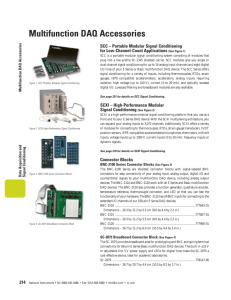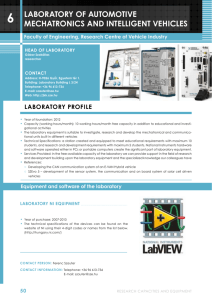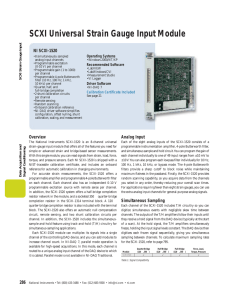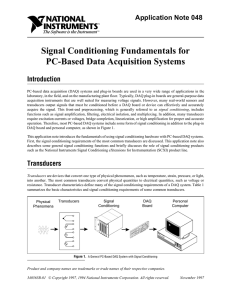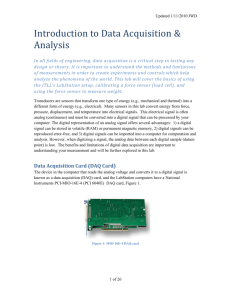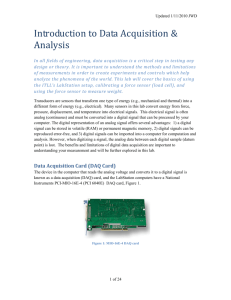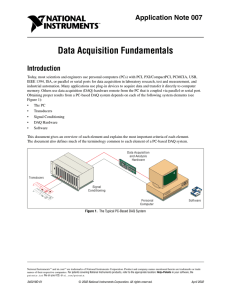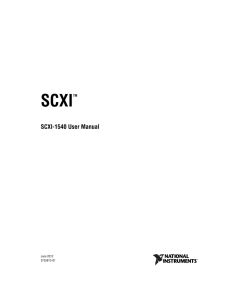SCXI 8-Channel Simultaneous
advertisement
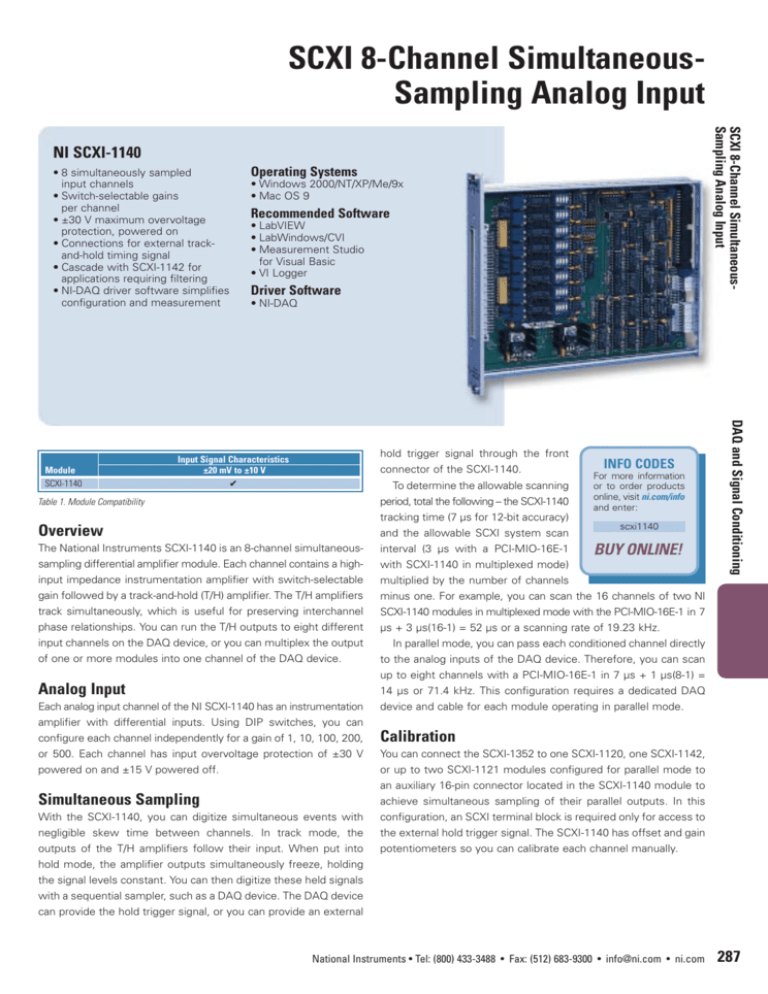
SCXI 8-Channel SimultaneousSampling Analog Input • 8 simultaneously sampled input channels • Switch-selectable gains per channel • ±30 V maximum overvoltage protection, powered on • Connections for external trackand-hold timing signal • Cascade with SCXI-1142 for applications requiring filtering • NI-DAQ driver software simplifies configuration and measurement • Windows 2000/NT/XP/Me/9x • Mac OS 9 Recommended Software • LabVIEW • LabWindows/CVI • Measurement Studio for Visual Basic • VI Logger Driver Software • NI-DAQ Input Signal Characteristics ±20 mV to ±10 V ✔ Table 1. Module Compatibility Overview The National Instruments SCXI-1140 is an 8-channel simultaneoussampling differential amplifier module. Each channel contains a highinput impedance instrumentation amplifier with switch-selectable gain followed by a track-and-hold (T/H) amplifier. The T/H amplifiers track simultaneously, which is useful for preserving interchannel phase relationships. You can run the T/H outputs to eight different input channels on the DAQ device, or you can multiplex the output of one or more modules into one channel of the DAQ device. Analog Input Each analog input channel of the NI SCXI-1140 has an instrumentation amplifier with differential inputs. Using DIP switches, you can configure each channel independently for a gain of 1, 10, 100, 200, or 500. Each channel has input overvoltage protection of ±30 V powered on and ±15 V powered off. Simultaneous Sampling With the SCXI-1140, you can digitize simultaneous events with negligible skew time between channels. In track mode, the outputs of the T/H amplifiers follow their input. When put into hold mode, the amplifier outputs simultaneously freeze, holding the signal levels constant. You can then digitize these held signals with a sequential sampler, such as a DAQ device. The DAQ device can provide the hold trigger signal, or you can provide an external hold trigger signal through the front INFO CODES connector of the SCXI-1140. For more information To determine the allowable scanning or to order products online, visit ni.com/info period, total the following – the SCXI-1140 and enter: tracking time (7 µs for 12-bit accuracy) scxi1140 and the allowable SCXI system scan interval (3 µs with a PCI-MIO-16E-1 BUY ONLINE! with SCXI-1140 in multiplexed mode) multiplied by the number of channels minus one. For example, you can scan the 16 channels of two NI SCXI-1140 modules in multiplexed mode with the PCI-MIO-16E-1 in 7 µs + 3 µs(16-1) = 52 µs or a scanning rate of 19.23 kHz. In parallel mode, you can pass each conditioned channel directly to the analog inputs of the DAQ device. Therefore, you can scan up to eight channels with a PCI-MIO-16E-1 in 7 µs + 1 µs(8-1) = 14 µs or 71.4 kHz. This configuration requires a dedicated DAQ device and cable for each module operating in parallel mode. DAQ and Signal Conditioning Module SCXI-1140 Operating Systems SCXI 8-Channel SimultaneousSampling Analog Input NI SCXI-1140 Calibration You can connect the SCXI-1352 to one SCXI-1120, one SCXI-1142, or up to two SCXI-1121 modules configured for parallel mode to an auxiliary 16-pin connector located in the SCXI-1140 module to achieve simultaneous sampling of their parallel outputs. In this configuration, an SCXI terminal block is required only for access to the external hold trigger signal. The SCXI-1140 has offset and gain potentiometers so you can calibrate each channel manually. National Instruments • Tel: (800) 433-3488 • Fax: (512) 683-9300 • info@ni.com • ni.com 287 DAQ and Signal Conditioning SCXI 8-Channel SimultaneousSampling Analog Input SCXI 8-Channel SimultaneousSampling Analog Input Figure 1. SCXI-1140 Block Diagram Terminal Block Type Special Functions Page SCXI-1301 Screw terminals – 310 (777687-01) front-mounting SCXI-1304 Screw terminals AC coupling 310 (777687-04) front-mounting Signal ground referencing SCXI-1305 BNC Connectors BNC connectors 310 (777687-05) front-mounting, Signal AC coupling ground referencing SCXI-1310 Solder pins Low-cost connector 310 (777687-10) and shell assembly Ordering Information SCXI-1140 ............................................................776572-40 For information on extended warranty and value added services, see page 20. See page 252 for more information on a complete SCXI system. Figure 2. Terminal Block Options for SCXI-1140 288 National Instruments • Tel: (800) 433-3488 • Fax: (512) 683-9300 • info@ni.com • ni.com DAQ and Signal Conditioning SCXI Accuracy Specifications Accuracy Specifications for Signal Conditioning Web Resources Web Resources Subhead 1 Web Resources Text Every Measurement Counts There is little room for error in your measurements. From sensor to software, your system must deliver accurate results. NI provides detailed specifications for our products so that you do not have to guess how they perform. Along with traditional specifications, our signal conditioning products include accuracy tables to assist you in selecting the appropriate hardware for your application. These tables are found on the specification pages for each product. Absolute Accuracy Absolute accuracy is the specification you must use to determine the overall maximum possible error of your measurement. Absolute accuracy does assume your signal conditioning equipment has been calibrated within the last year. There are four main components of an absolute accuracy specification: • % of Reading is an uncertainty factor that is multiplied by the actual imput voltage for the measurement • Offset is a constant value applied to all measurements • System Noise is based on noise and depends on the number of points averaged for each measurement • Temperature Drift is based on variations in your ambient temperature. Absolute Acuracy RTI stands for relative to the input Temperature effects are already taken into account unless your ambient temperature is outside of the 15 to 35 °C range. For instance, if your ambient temperature is at 45 °C, you must account for 10 °C of drift. This is calculated by: Temperature Drift = ± (Actual Input Voltage x % of Reading/°C + Offset/°C) x Temperature Difference Below is an example for calculating the absolute accuracy for the SCXI-1102 using the ±100 mV input range while averaging 100 samples of a 14 mV input signal. In this calculation, we assume the ambient temperature is between 15 and 35 °C, so Temperature Drift = 0. Using the accuracy table on pge 262, you find the following numbers for the calculation: Actual Input Voltage = 0.014 Percent of Reading Max = 0.02% = 0.0002 Offset = 0.000025 V System Noise = 0.000005 V Absolute Accuracy = ±[(0.014 x 0.0002) + 0.000025 + 0.000005] V = ±32.8 µV Absolute Accuracy RTI = ±(0.0000328 / 0.014) = ±0.234 % Based on these components, the formula for calculating absolute accuracy for a given module is: Absolute Accuracy = (Actual Input Voltage x % of Reading) The following example assumes the same conditions, except the ambient temperature is 40 °C. You can begin with the Absolute Accuracy calculation above and add in the Temperature Drift. + Offset + System Noise + Temperature Drift Absolute Accuracy = 32.8 µV + (0.014 x 0.000005 + 0.000001) x 5 = ±38.15 µV Absolute Accuracy RTI = ±(Absolute Accuracy/Actual Input Voltage) 254 National Instruments • Tel: (800) 433-3488 • Fax: (512) 683-9300 • info@ni.com • ni.com Accuracy Specifications for Signal Conditioning Note, it is important to use a typical measurement value in this process, because many conversion algorithms are not linearized. You may want to perform conversions for several different values in your probable range of inputs. Absolute Accuracy RTI = ±(0.00003815 / 0.014) = ±0.273 % If you are making single-point measurements, use the SinglePoint System Noise specification from the accuracy table. If you are averaging multiple points for each measurement, the value for System Noise changes. The Average System Noise provided in the accuracy table assumes that you average 100 points per measurement. If you are averaging a different number of points, use the following equation to determine your system noise: System Noise = Average System Noise from table x SQRT(100/number of points) System Noise = 5 µV x SQRT (100/1000) = 1.58 µV Absolute System Accuracy Absolute System Accuracy represents the end-to-end accuracy including the signal conditioning and DAQ device. Because absolute system accuracy includes components set for different input ranges, it is important to use Absolute Accuracy RTI numbers for each component. See page 194 for information on how to calculate the Absolute Accuracy RTI for your particular DAQ device. Total System Accuracy RTI = ±SQRT [(Module Absolute Accuracy RTI)2 (1) A J-type thermocouple at 100 °C generates 5.268 mV (from a standard conversion table or formula) (2) The absolute accuracy for the system at 5.268 mV is ±0.59%. This means the possible voltage reading is anywhere from 5.237 to 5.299 mV. (3) Using the same thermocouple conversion table, these values represent a temperature spread of 99.4 to 100.6 °C. Therefore, the absolute system accuracy is ±0.6 °C at 100 °C. Benchmarks The calculations described above represent the maximum error you should receive from any given component in your system, and a method for determining the overall system error. However, you typically have much better accuracy values than what you obtain from these tables. If you need an extremely accurate system, you can perform an end-to-end calibration of your system to reduce all system errors. However, you must calibrate this system with your particular input type over the full range of expected use. Accuracy depends on the quality and precision of your source. We have performed some end-to-end calibrations for some typical configurations and achieved the results below: DAQ and Signal Conditioning For example, if you are averaging 1,000 points per measurement with the SCXI-1102 in the ±100 mV range, the system noise is determined by: For an example calculation, we want to determine the absolute system accuracy of an SCXI-1102 system with a PCI-MIO-16XE-50, measuring a J-type thermocouple at 100 °C. SCXI Accuracy Specifications In many cases, it is helpful to calculate this value relative to the input (RTI). Therefore, you do not have to account for different input ranges at different stages of your system. + (DAQ Device Absolute Accuracy RTI) 2] The following example calculates the Absolute System Accuracy for the SCXI-1102 described in the first example, and a PCI-MIO-16XE-50 with an Absolute Accuracy RTI of 0.00368%. Total System Accuracy RTI = ±SQRT [(0.00273)2 + (0.00003682)] = ±0.273% Units of Measure In many applications, you are measuring some physical phenomenon, such as temperature. To determine the absolute accuracy in terms of your unit of measure, you must perform three steps: (1) Convert a typical expected value from the unit of measure to voltage (2) Calculate absolute accuracy for that voltage (3) Convert absolute accuracy from voltage to the unit of measure Module SCXI-1102 SCXI-1112 SCXI-1125 Empirical Accuracy ±0.25 ˚C at 250 ˚C ±24 mV at 9.5 V ±0.21 ˚C at 300 ˚C ±2.2 mV at 2 V Table 1. Possible Empirical Accuracy with System Calibration To maintain your measurement accuracy, you must calibrate your measurement device at set intervals. Calibration improves your accuracy and ensures that your end product meets its required specifications. We are continually updating the calibration services available for our products. For a current list of SCXI signal conditioning products with calibration services, please visit ni.com/calibration National Instruments • Tel: (800) 433-3488 • Fax: (512) 683-9300 • info@ni.com • ni.com 255
